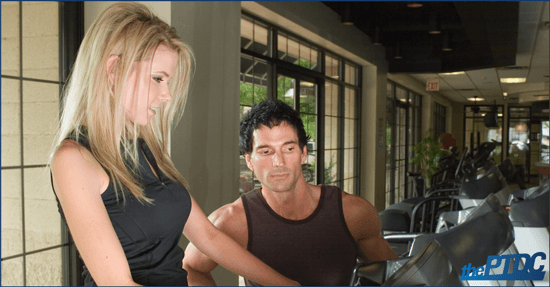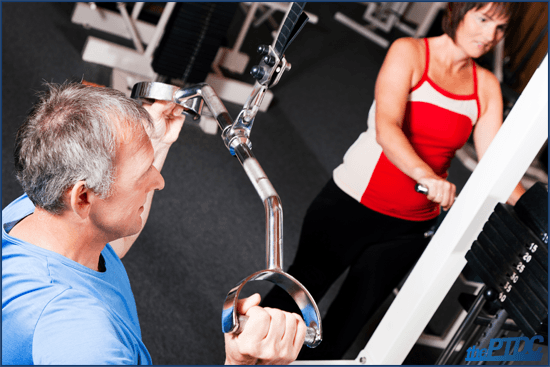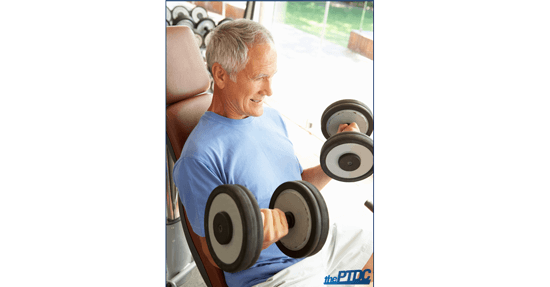Whether you train at a commercial gym or own your own facility, chances are cancer survivors aren't going to be on the top of your client list. Nevertheless, with cancer being the most common disease in the world, exercise advice for cancer survivors is imperative for you to be aware of. Cancer survivors are a unique population. While the pathophysiology of the disease, treatments, and different types of cancer are beyond the scope of this article, here are some tips that may help if you happen to find yourself training a survivor. 
Side effects of treatment
The side effects of treatment, both physiological and psychological, can greatly affect a survivor's functional ability and their quality of life. The closer a survivor is to treatment, the more severe the side effects are going to be. During ongoing treatment, particularly chemotherapy and radiation, survivors will experience extreme fatigue, lapses in concentration, and mood swings among others. As they then progress from active treatment to completion of treatment, the side effects may become less pronounced. Knowledge of these side effects and appropriate modification of exercises or overall sessions to adjust to them is critical to your client's adherence and success with training. A brief outline of the possible side effects as a result of different treatments are outlined below in this article about exercise advice for cancer survivors:
Bone Mineral Density Low bone mineral density (BMD) is one of the more common side effects of treatment, particularly radiation or hormonal treatment. The lower bone mineral density, coupled with muscle atrophy from inactivity, can increase the risk of falls, fractures, and osteoporosis in survivors. The importance of resistance training in survivors can't be emphasized enough. It can almost reverse the effects of low BMD, increase muscle mass, and improve functional ability in survivors.
Lymphedema Radiation or surgery can cause damage to lymph nodes (most common in breast cancer). The damage to the lymph nodes can cause difficulty transporting fluid through the lymphatic vessels, resulting in lymphedema. It was previously thought that exercise, particularly resistance training, could exacerbate the effects of lymphedema in survivors. However, there's been a lot of research in recent years to suggest that resistance exercise is safe and effective and may even improve lymphatic flow (due to muscle contractions and overall increase tonus). Weekly monitoring of circumference of the affected limb can help provide feedback on the status of the lymphedema. Consider asking a survivor to wear a compression sleeve to facilitate flow throughout the limb.
Immune function Cancer treatment, particularly chemotherapy, targets rapidly dividing cells. Unfortunately this includes red and white blood cells, which can result in anemia and an immunosuppressed status. Anemia can cause extreme fatigue during exercise, while a suppressed immune system increases the susceptibility of infection. Survivors undergoing chemo treatment should be aware of this and be adjust the volume and intensity of training accordingly. Additionally, caution should be taken at public gyms where the risk of infection may be higher.
Peripheral Neuropathy Peripheral neuropathy (PN), which can be described as numbness or tingling of the extremities, particularly hands and feet, can be a common side effect of radiation or chemotherapy. Survivors with PN can have trouble holding free weights, maintaining balance, and even have coordination issues. Thus it becomes important to modify and substitutes exercises that may be appropriate.
Cancer-related fatigue Cancer related-fatigue (CRF) is an all-encompassing term that describes an overwhelming fatigue that can include sleep apnea, depression, distress, and a lower functional capacity. CRF occurs on an individual basis and can last for days, months, and even years following treatment. It's important when working with survivors to monitor CRF each session. It may be beneficial to spend the first few minutes during your session to talk to your client, ask them how they're feeling, and try to get a feel for their readiness to exercise. Survivors will also experience other side effects of treatment, including necrosis, cardio toxicity, pain, hot flashes, skin damage etc. A complete list of these side effects is beyond the scope of this article, but it's imperative that a full medical history and symptom list is completed so you know what they're experiencing and will be better able to navigate it. 
Testing, exercise prescription, and current guidelines.
Before beginning an exercise program with a client, it's essential that a physician's referral or clearance and a medical history be obtained. This will help identify the type and duration of treatment they received, as well as any other comorbities (arthiritis, heart disease etc) that they may have. Additionally, this helps build a rapport between you and their primary physician which is crucial -- not only in optimizing the care the survivor receives, but to establishing yourself as a trusted, quality trainer among the medical community. While the field of exercise oncology is growing rapidly, unfortunately there are some physicians that are still hesitant to prescribe the appropriate volume and intensity of exercise to survivors.
By keeping lines of communication with a survivor's physician open and doing periodical "check-ins" you may find that they become more willing to refer clients to you. Testing and prescription is going to be largely dependent on the survivors' goals, and their functional ability. As previously mentioned, the more progressed the disease, ordering active treatment, the physiological decrements will be a lot more pronounced than following treatment.
This raises a key point when working with survivors during treatment. Motivation to start and maintain exercising is most likely going to be very low. It should be stressed to the survivor that their goal of exercise during treatment isn't necessarily to see drastic improvements in physical fitness, but to maintain current physical condition for the duration of treatment. As a survivor then progresses through treatment, the side effects will become less pronounced, and goals can shifts back to improvements in physical fitness and improvements. Testing can range anywhere from functional tests, such as the senior fitness test (a battery of tests specific to the functional ability of older adults), to general strength and endurance tests (1rm or 1.5 walk/run test). As always, the rule of thumb is to evaluate the clients physical capabilities as best you can and choose appropriate tests to administer. It may even be beneficial to use a quality of life scale (some of which are cancer specific), to get a snapshot of their mental health -- you'll be pleasantly surprised at how much this can improve with chronic exercise. Likewise with prescription - it's best to err on the side of caution and progress at a slower rate than you would with otherwise healthy adults. Here are some other tips:
-
-
- Due to cancer-related fatigue (a term for a chronic, exhausting feeling that can last for months if not years following treatment), an undulating program may be warranted. I've used a sort of auto regulation model where the first 5 minutes of your warm-up is asking the client how they feel and gauging their energy levels. From this you can decide to go into the lower strength-range reps, or come out to a more hypertrophy or even endurance emphasis.
-
-
-
- Chemo-brain, another awful side effect of treatment that can cause cognitive deficits, including memory issues. This may result in you having to explain how to perform an exercise several times over. This requires both patience and understanding on continue to reinforce correct form.
-
-
-
- In my experience, survivors have been apprehensive about starting exercise, often times due to physician recommendations (Thankfully this is changing dramatically), who will have either recommend insufficient levels, if any of physical activity. Even worse, numerous clients have told me that their physician told them not to lift more than a gallon of milk (~8.5lbs) over their heads! It's important to build trust with you client and stress the safety of exercise to ease their nerves.
-
-
-
- Make it fun! Survivors, for the most part have been through hell -- they get poked, prodded, operated on and then some, for hours each day. Most likely coming to you to begin an exercise program is their release from it all. The last thing they want to do is feeling like they have to go exercise. Get them excited about it, make them forget all the other stuff going on, and for the time they're with you, focus on the enjoyment that mastery of exercise brings!
-
Site-Specific Considerations
Breast Cancer Breast cancer survivors will experience range of motion issues with upper extremities, which can be the result of surgery to remove lymph nodes or a tumor. Additionally, there are other procedures such as a TRAM flap or latissimus dorsi flap where fat, skin, and blood vessels are cut from the stomach area or the latissiumus area, and moved to the chest to rebuild breast size and shape. "¨"¨This can result in tightness, a reduced range of motion, and even reduced strength in both the chest and abdominal areas. Should this be the case, frontloading with flexibility is warranted, with the goal to increase the range of motion to prep for strength training.
Additionally, survivors can also have port-a-catheters inserted around their pectoral muscle for chemotherapy infusion. It's imperative to take caution with pressing exercises, as you don't want to dislodge the port. It's likely the affected side of surgery or a port inserted will be noticeably weaker. In this case, consider unilateral exercises on the unaffected side. "¨"¨There is some research to suggest that cross-education may occur where small increments in strength may be seen in the untrained limb as a result to unilateral training. Prostate  One of the most common treatments for prostate survivors is androgen deprivation therapy (ADT) to reduce levels of male hormones, or androgens, which can often lead to cancer cell growth. Unfortunately, the side effects of this can be a reduction in testosterone levels, decrease bone mineral density, muscle atrophy, fatigue and insulin resistance. There has been a wealth of research supporting the safety and efficacy of exercise, particularly resistance exercise in prostate survivors. More importantly, the physiological adaptations to resistance training can attenuate and almost reverse the decrements associated with ADT. Therefore it's highly recommended for prostate survivors to emphasize a progressive resistance-training program. The addition of cardiovascular training will complement this with some aerobic adaptations and may aid in reducing blood pressure and improving body composition.
One of the most common treatments for prostate survivors is androgen deprivation therapy (ADT) to reduce levels of male hormones, or androgens, which can often lead to cancer cell growth. Unfortunately, the side effects of this can be a reduction in testosterone levels, decrease bone mineral density, muscle atrophy, fatigue and insulin resistance. There has been a wealth of research supporting the safety and efficacy of exercise, particularly resistance exercise in prostate survivors. More importantly, the physiological adaptations to resistance training can attenuate and almost reverse the decrements associated with ADT. Therefore it's highly recommended for prostate survivors to emphasize a progressive resistance-training program. The addition of cardiovascular training will complement this with some aerobic adaptations and may aid in reducing blood pressure and improving body composition.
Lung Unsurprisingly, lung cancer survivors tend to have a severely comprised cardiorespiratory system. The disease itself, or resulting treatments, coupled with deconditioning can lead to a reduction in substrate utilization and VO2 peak. Chronic aerobic training can aid in increasing VO2peak and substrate utilization. However it should be noted that a survivor may have had part, or all of their lung removed, or may have suffered from cell necrosis from radiation to the chest wall. This may drastically affect their aerobic tolerance; fewer smaller sessions broken up throughout the day or even interval sessions with longer rest periods may be methods to navigate this. Resistance training should also be included to attenuate muscle atrophy and improve strength.
Other The field of exercise oncology is still in its infancy -- the cancer sites that have been extensively studied are done so because they are the most prevalent. The reason other sites haven't been studied extensively is largely due to the inability to recruit large enough numbers for randomized controlled trials. Thus little evidence exists in terms of specific contraindications or recommendations of some of the "less common" forms of cancer. What should be apparent as you read through this article though, is the overwhelming support for the safety and efficacy of exercise in cancer survivors, both during and post treatment.
As with site-specific considerations, as obvious as it may sound, a patient will be most affected around their site where the tumor was. Neck and throat cancer survivors for exampled, may experience nausea and appetite issues more than others, brain cancer survivors may experience concentration and memory issues more than others. As a professional, you should be able to think critically about each client and use their background information along with results of some preliminary tests to identify any potential limitations and come up with modifications to your program as a result.
Motivation and adherence
This is tricky. Some survivors are ready to kick the disease in the backside and get cracking full on, whereas others may need an arm around the shoulder and a lot more motivation and encouragement to get through a workout. This all comes with experience in feeling your client out, learning their personality and how to mesh well together!
I've found that both one-one personal training or small group training are very effective at increasing participation, effort and adherence to exercise. The smaller groups also offer a great source of social support with individuals going through similar experiences. In my experience (it may not always be the case), that the larger the group, the easier it is for clients to skip out as the accountability seems to be diluted with a larger group.
Scope of practice as a health professional
Just as if someone came to you with diastasis recti, or diabetes, or back pain, it's imperative that if you find yourself working with a survivor that you research the disease, the treatment they were on (even down to the specific chemotherapy drug), and the side effects. The field of exercise oncology is ever evolving. We're at the exciting part, where we as researchers are figuring out what works, what doesn't, and optimal dose-response relationships of exercise. Thus, it's imperative to stay current with the literature and implement the most effective program you can.
Additional Resources:
The list of resources below is not exclusive, but they are some of the top websites, books for personal trainers, etc. for providing concise, and accurate information on cancer and exercise.
REACH (Research in Exercise And Cancer Health): A non-profit organization aimed to translate the latest research into tangible, easy to interpret information for the general public. Through videos, blogs, and reviews, they provide evidence-based recommendations for exercise. The organization also offers free consultations to any survivor looking to get started with exercise.
Website: http://reachformore1.wix.com/reach
Facebook: https://www.facebook.com/pages/REACH-Research-in-Exercise-And-Cancer-Health/314246698740556?
Organizations:
MD Anderson Clinic: http://www.mdanderson.org/
National Cancer Institute: http://www.cancer.gov/
American Cancer Society: http://www.cancer.org/
Books and Book Chapters:
ACSM's Guide to Exercise and Cancer Survivorship. Melinda Irwin, 2012. One of the best resources for those interested in working with survivors. It provides information on cancer, it's treatment, side effects, and individualization of exercise by site.
Resistance exercise interventions across the cancer control continuum. Brian C. Focht, Alexander Lucas, and Steven D. Clinton. A chapter from the book "Resistance training for the treatment and prevention of chronic diseases". The authors provide a great review of the literature investigating resistance training in different cancer and provide recommendations for prescription and progression.
Therapeutic Physical activities for people with cancer. Kristina L. Kendall, Ciaran M. Fairman. (still in writing) This book chapter provides a brief overview of the side effects of treatment for cancer and how exercise can attenuate these. It gives site specific recommendations for resistance and aerobic training.
American College of Sports Medicine's Roundtable on Exercise Guidelines for Cancer Survivors. A fantastic review of exercise oncology published by ACSM in 2010. It still remains one of the best resources on the safety and efficacy of exercise in different cancers. The article is freely available on ACSM's website.










